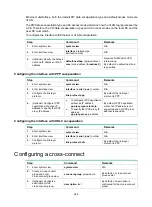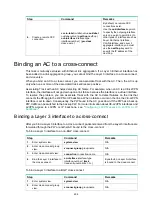
390
For example, a VPN has 10 sites, and a PE assigns the first label block LB1/0/10 to the VPN.
When another 15 sites are added, the PE keeps the first label block and assigns the second
label block LB2/10/15 to extend the network. LB1 and LB2 are the initial label values that are
randomly selected by the PE.
•
Route
target
—PEs use the BGP route target attribute (also called VPN target attribute) to
manage BGP L2VPN information advertisement. PEs support the following types of route target
attributes:
{
Export target attribute
—When a PE sends L2VPN information to the peer PE in a BGP
update message, it sets the route target attribute in the update message to an export target.
L2VPN information includes the site ID, RD, and label block.
{
Import target attribute
—When a PE receives an update message from the peer PE, it
checks the route target attribute in the update message. If the route target value matches an
import target, the PE accepts the L2VPN information in the update message.
Route target attributes determine from which PEs a PE can receive L2VPN information.
MPLS L2VPN network models
MPLS L2VPN network models include the remote connection and local connection models.
Remote connection model
As shown in
, this model connects two CEs through a PW on an MPLS or IP backbone.
Figure 100 Remote connection model
Local connection model
As shown in
, this model connects two CEs to the same PE so the CEs can communicate
through the PE.
Figure 101 Local connection model
AC
AC
















































